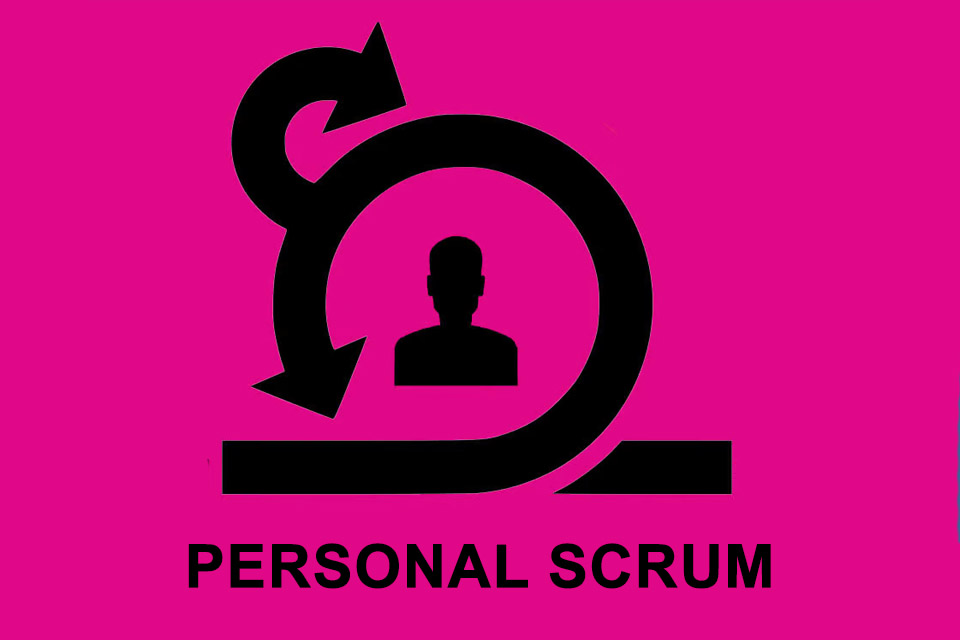What is Personal Scrum?
Smartpedia: Personal Scrum is an adaptation of Scrum that provides assistance to individuals in the organisation and tracking of personal and professional goals, topics or activities.
Personal Scrum – a Scrum adaptation for individuals
Scrum is a framework with events, responsibilities and artefacts for the development of complex products and services. While Scrum addresses team development, Personal Scrum is aimed at individuals. The purpose of the adaptation is the organisation and tracking of private and/or professional goals, topics or activities. Alternative terms for Personal Scrum are, for example.
- Scrum of One,
- Solo Scrum or
- Solo Scrumming.
In contrast to the Scrum Guide, which describes the “classic” Scrum with its rules and was updated in 2020 with numerous simplifications, innovations and clarifications, there is no final work that defines Personal Scrum. Below you will find some descriptions of how the framework could also offer advantages for individuals:
Personal Scrum – a set of lists, events and practices
Simon Kneafsey1, a professional British Scrum trainer describes a Personal Scrum System2 with
- objectives,
- measures,
- activities and
- tasks.
An objective describes a future state that is different from the current state and desirable for an individual. Measurements define criteria for determining the achievement of the goal. Activities describe actions that need to be implemented to achieve the objective. And tasks define aspects to complete the activities. Together, the four elements form a structure that helps to achieve objectives more easily in a private or professional context. Ideally, clarity about the structure increases the likelihood of success.
In addition to this structure, Simon Kneafsey identifies
- eight lists for documenting goals and activities to achieve them,
- five events for continuous planning and review of progress towards goals,
- and more than 20 complementary practices for goal achievement.
The lists are a tool that individuals can use to present goals in a transparent and manageable way:
- Ideas List to collect goals and activities that may be worthwhile and useful but have not yet been tackled.
- Goal List with defined goals to work towards.
- To-do List with defined activities to achieve goals.
- Weekly List with goals and activities to be achieved or completed within the current week.
- Today List with the planned activities of the day.
- In Progress List with the activities that are currently being carried out.
- On Hold List with activities that are waiting for something or someone.
- Done List with achieved goals and completed activities.
These lists can be visualised, for example, with a shared whiteboard on which the individual lists are displayed as columns so that an overview can be gained quickly at a glance.
Simon Kneafsey sees the events as deliberate points for planning and reviewing progress:
- Yearly Planning to plan goals and activities to be addressed within a year. As a result, single and multiple strategic, long-term goals are recorded.
- Quarterly planning to plan medium-term goals and activities, broken down to the next quarter. Possibly medium-term goals pay off on long-term goals.
- Weekly planning for concrete planning of activities and tasks as small units to achieve goals within the next week.
- Daily planning to plan activities and tasks for a specific day.
- Ongoing Planning to review, update and plan goals, activities and tasks. This continuous planning can be done at any time.
Ongoing planning is a special event because, unlike the other plans that refer to a concretely defined period of time (year, quarter, week and day), it is more of a continuous activity. It is striking that they do not speak of sprints in the sense of Scrum, but of classic schedules; unfortunately, it is not directly obvious what this has to do with events.
Last but not least, Simon Kneafsey names more than 20 practices that can be useful in planning and achieving the individual’s private or professional objectives:
- Learning as the ability to deal with new things in order to understand them. The ability to learn can also be learned.
- Concentration as an appeal to avoid or eliminate distractions in order to be able to concentrate on the essential.
- Flow state as a motive, because in a flow state users can get more done.
- Prioritisation to evaluate similar elements – e.g. tasks, activities, goals – according to consciously chosen criteria, with the claim to determine a meaningful order.
- Perseverance as an attitude, because perseverance helps to achieve goals, even if the implementation of an activity is difficult.
- Timeboxing as a technique to plan and time activities.
- Pomodoro Technique as a way of working with short blocks of time to increase concentration.
- 80/20 Rule as an indication of a small number of high values contributing more to the total value of a defined set of values than a high number of small values.
- Inbox Zero as an incentive to minimise the number of emails in the inbox so that no unnecessary stress is created.
- Touch It Once as an encouragement to complete tasks that can be completed quickly and directly.
- Getting Started as a reminder not to put off tasks and activities unnecessarily.
- Maximising Unfinished Activities as an appeal to actively decide which activities not to tackle.
- Knowing when to stop as a mental support, because sometimes it is necessary to change goals and plans.
- Goal after goal as a recommendation to work with strategic and tactical goals to stay motivated.
- SMART goals as a means to formulate specific, measurable, attractive, realistic and timed goals.
- Limiting workload with the intention of getting more done by taking on less.
- Just-in-time decision making with the recommendation to postpone decisions to the latest and safest point.
- Moving away from traditional to-do lists, as they are too simplistic and don’t work.
- Getting help as an appeal to secure support when it is too hard to do alone.
- Saying no as mental support, because it’s OK to say no to things.
- Kaizen as an aspiration for continuous improvement.
- Investing in oneself as an indication that personal development is very sustainable.
- Using mentors and coaches as support and thus benefiting from other experiences.
It is striking that the practices are a colourful mix of methods, good practices and life lessons. Positively formulated, the practices mentioned complement each other. Critically, they are often so general that a detailed discussion could lead to far-reaching discussions; it is good that Personal Scrum is aimed at individuals and thus the corresponding discussions may be relatively short.
Alternative Personal Scrum approaches
There are some approaches that address the use of Scrum for individuals somewhat less extensively. Here are some elements that may be useful:
- The use of three different tasks (Business Tasks, Home Tasks and Personal Tasks) managed in a common backlog, followed by Sprint Planning, Sprint, Daily Scrums and Review.3
- Adjusting or fixing the timeboxes for Sprints (1 week) and Daily Scrums (5 minutes).4
- The use of Personal Scrum for a single concrete, private project, including a definition of short-term goals and the daily allocation of time to continuously work towards the overall goal.
In addition, there are some attitudes that promote the use of Personal Scrum:
- Transparency and honesty with oneself or self-reflection are important.
- The deliberate elimination of impediments and the use of a Definition of Done are considered purposeful.
- Even if the goal seems big and difficult for an individual to achieve, any action towards the goal is a good step.
- The use of tools, e.g. to show planned, current or completed activities or to visualise progress, is useful.
Last but not least, good practices can be very useful. Nobody awards grades or certificates when using Personal Scrum, nobody criticises a deviation from “usual” Scrum practices. Personal Scrum is personal in the best sense of the word.
The Scrum Guide postulates: “It is possible to implement only parts of Scrum, but the result is not Scrum. Scrum exists only in its totality…”. This totality also includes three concrete accountabilities. If there is only one accountability in Personal Scrum – the individual – then it is not Scrum, is it?
Notes:
[1] Information about Simon Kneafsey
[2] Personal Scrum System
[3] How to Apply Scrum to Personal Projects
[4] Can Personal Scrum be Used for a Team of One?
Personal Scrum could also be applied within a family. In such a setting, accountabilities can certainly be defined, but separate roles are probably not needed.
If you like the article or would like to discuss it, please feel free to share it in your network. And if you have any comments, please do not hesitate to send us a message.
And here you will find additional information from our t2informatik Blog:




